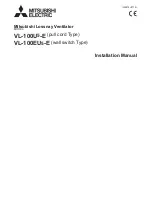
Installation Instructions
Specifi cations are subject to change without notice
Page 1
[email protected] | www.manrose.co.nz
Distributed by Simx Limited
Through Roof Fan Cowls and Fan Kits
ELECTRICAL CONNECTION
NOTE: Junction box supplied is suitable for internal use and below roof installation
(inside the building)
• Cut the roof fl ashing on the 240/255 marking and fi t to the rigid duct before commencing (see separate
installation sheet detailing this).
• For below roof terminations the motor lead exit hole should be as far down the rigid duct as is practical –
allow enough lead to protrude from the duct as is required for termination. After fi tting the roof fl ashing, drill
an 8mm hole at a suitable point in the rigid duct and fi t the supplied rubber grommet. The motor lead can
then be passed through the grommet to the outside of the rigid duct.
• The assembly can now be placed in position in the roof penetration (see instructions on page 3). Once the
assembly has been fastened to the roof by the roof fl ashing fastening procedure, the electrical connections
can be made. The junction box can be fastened to the rigid duct if necessary.
Junction box is supplied for the following cowls and kits with an inline centrifugal fan:
FAN2120 / FAN2122
Junction box is supplied for the following cowls and kits with an inline high performance
centrifugal
fan:
FAN2121 / FAN2123
• You may fi nd it more convenient to pull the whole assembly down as far as possible in the roof fl ashing
to carry out the terminations (Fig 1). Once completed, the assembly can then be pushed back up through the
Dektite. Ensure that a visual check is made above the roof afterwards to check that the roof fl ashing is sealing
correctly around the rigid duct (Fig 2). Once the terminations are completed the rigid duct can then be
fastened to a rafter or purlin with the supplied clamp for rigidity. Ducting connections can then be made.
• Precautions must be taken to avoid the back-fl ow of gases into the room from the open fl ue of gas or other
fuel-burning
appliances.
Please ensure these instructions are read thoroughly before commencing installation
and that all documentation is left with the home owner on completion of installation
CAUTION
• Before use, please check that the supply voltage and that of the appliance are the same (see product rating label).
• All wiring and wiring connections must comply with national wiring rules and regulations.
• Any changes or modifi cations made or attempted to this product, without the prior written approval of the manufacturer, will void any and all
stated
warranties.
• This appliance is not intended for use by persons (including children) with reduced physical, sensory or mental capabilities, or lack of
experience and knowledge, unless they are capable of, and have been given supervision or instruction concerning use of the appliance by a
person responsible for their safety.
• Children should be supervised to ensure that they do not play with the appliance.
• In case of damage to the supply cord, switch off the device and do not tamper with it. Damaged supply cords must only be repaired or
replaced exclusively by the manufacturer or by an appointed representative. Failure to comply with the above may endanger the safety of
people and cause possible damage to the whole system.
• Precautions must be taken to avoid the back-fl ow of gases into the room from the open fl ue of gas or other fuel-burning appliances.
Fig 1
Fig 2
TECHNICAL
Duct
(mm)
Fan Type
Max.
Fan Watts
(W)
Max.
Fan Pressure
(Pa)
Free Air Fan
Performance
Specific
Fan Power
(W/l/s)
Sound
dB(A)
Switching
(l/s)
(m
3
/hr)
250
Centrifugal
75
300
178
640
0.42
72
Standard
Centrifugal
(high performance)
135
545
265
954
0.51
70
Standard























